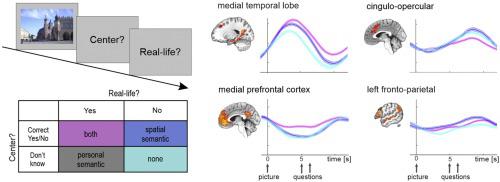Behavioural Brain Research ( IF 2.6 ) Pub Date : 2020-10-24 , DOI: 10.1016/j.bbr.2020.112976 Ewa Beldzik 1 , Aleksandra Domagalik 2 , Magdalena Fafrowicz 1 , Halszka Oginska 1 , Tadeusz Marek 1

|
Have you ever been to Krakow? If so, then you may recognize the Wawel Royal Castle from a picture due to your personal semantic memory, which stores all autobiographically significant concepts and repeated events of your past. If not, then you might still recognize the Wawel Royal Castle and be able to locate it on a map due to your spatial semantic memory. When recognizing a familiar landmark, how does neural activity depend on your memory related to that place? To address this question, we combined a novel task – the Krakow paradigm – with fMRI. In this task, participants are presented with a set of pictures showing various Krakow landmarks, each followed by two questions – one about its location, and the other about seeing the place in real-life, to trigger spatial and/or personal semantic memory, respectively. Group independent component analysis of fMRI data revealed several brain networks sensitive to the task conditions. Most sensitive was the medial temporal lobe network comprising bilateral hippocampus, parahippocampal, retrosplenial, and angular gyri, as well as distinct frontal areas. In agreement with the contextual continuum perspective, this network exhibited robust stimulus-related activity when the two memory types were combined, medium for spatial memory, and the weakest for baseline condition. The medial prefrontal network showed the same, pronounced deactivation for spatial memory and baseline conditions, yet far less deactivation for places seen in real-life. This effect was interpreted as self-referential processes counterbalancing the suppression of the brain’s ‘default mode.’ In contrast, the motor, frontoparietal, and cingulo-opercular networks exhibited the strongest response-related activity for the spatial condition. These findings indicate that recognizing places based solely on general semantic knowledge requires more evidence accumulation, additional verbal semantics, and greater top-down control. Thus, the study imparts a novel insight into the neural mechanisms of place recognition. The Krakow paradigm has the potential to become a useful tool in future longitudinal or clinical studies.
中文翻译:

基于个人和空间语义的参与地点识别的脑网络
你去过克拉科夫吗?如果是这样,那么您可能会根据您的个人语义记忆从图片中认出瓦维尔皇家城堡,该记忆存储了您过去的所有自传性重要概念和重复事件。如果没有,那么您可能仍能认出瓦维尔皇家城堡,并能根据您的空间语义记忆在地图上定位它。在识别熟悉的地标时,神经活动如何取决于您与该地点相关的记忆?为了解决这个问题,我们将一项新任务——克拉科夫范式——与 fMRI 结合起来。在这项任务中,参与者会看到一组显示各种克拉科夫地标的图片,每张图片后面都有两个问题——一个关于它的位置,另一个关于在现实生活中看到这个地方,以触发空间和/或个人语义记忆,分别。fMRI 数据的组独立分量分析揭示了几个对任务条件敏感的大脑网络。最敏感的是内侧颞叶网络,包括双侧海马、海马旁回、脾后回和角回,以及不同的额叶区域。与上下文连续体的观点一致,当两种记忆类型结合时,该网络表现出强大的刺激相关活动,空间记忆中等,基线条件最弱。内侧前额叶网络在空间记忆和基线条件下表现出相同的、明显的失活,但在现实生活中看到的地方的失活要少得多。这种效应被解释为自我参照过程抵消了大脑“默认模式”的抑制。相比之下,运动、额顶、和 cingulo-opercular 网络在空间条件下表现出最强的响应相关活动。这些发现表明,仅基于一般语义知识识别地点需要更多的证据积累、额外的语言语义和更大的自上而下的控制。因此,该研究为地方识别的神经机制提供了新的见解。克拉科夫范式有可能成为未来纵向或临床研究的有用工具。











































 京公网安备 11010802027423号
京公网安备 11010802027423号